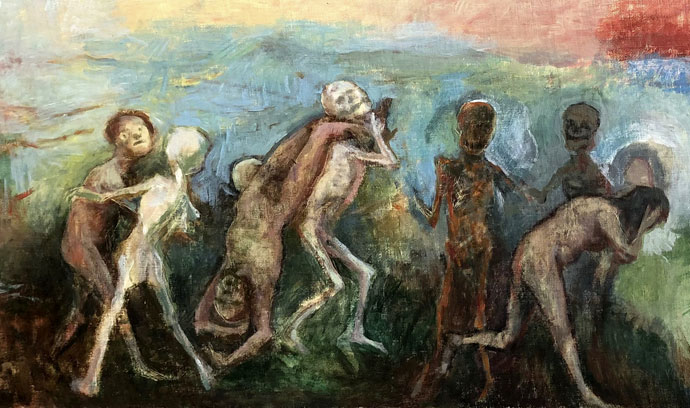Hubert de Chalvron 18/07>10/08
Chapelle de la maison Saint-Antoine

Après des études à l’école des Beaux arts d’Aix-en-Provence, Hubert de Chalvron, lauréat du Prix Fénéon en 1986, intègre le monde de l’art par des expositions dans des galeries parisiennes (galerie Gillespie Laage Salomon et galerie Marie-Hélène Montenay). Sa peinture a alors un caractère social (tableaux réalisés à la cristallerie de Saint Louis – Vosges).
Très vite son travail se consacre au renouvellement de sujet religieux tableaux des « Saints » exposés a la galerie en 1991 et dans l’exposition « désir de spiritualité dans l’art contemporain », C.C de Boulogne Billancourt.
Par la suite, l’artiste se concentre sur les paysages nivernais exposés en 1998. Enseignant à l’école des Beaux-arts de Brest, il sera sollicité pour enseigner aux étudiants chinois. Lors d’un voyage en Chine en 2014 Hubert de Chalvron rencontre une revue artistique (poésie calligraphie et peintures) qui s’intéresse à son travail de représentations religieuses et publie trois années de suite ses oeuvres (déposition, danses macabres, histoire de Job…etc).
En 2012 commencent les peintures ayant comme sujet les « danses macabres ». Une partie sera montrée sous le titre « Cadavres Exquis », dans l’église Sainte Claire à Paris au cours des « Nuits blanches » en 2018. Hubert de Chalvron vit et travaille à Paris et à Maux (Nièvre).
Danses Macabres
C’est en contemplant les dessins de Botticelli pour La Divine Comédie de Dante, ainsi que les enluminures des Très Riches Heures du duc de Berry, qu’est né le désir de créer les danses macabres. Ces œuvres se veulent comme une écriture sans mots, à la croisée de la musique, de l’écriture et de la peinture.
Le thème, bien sûr, est essentiel. Ces tableaux rappellent que la mort nous place tous sur un pied d’égalité, et cette conscience nous offre une forme de liberté, celle d’imaginer et d’exister pleinement.
Pour que ces œuvres puissent évoluer librement, comme une écriture automatique, il faut rester connecté à la réalité quotidienne. Tout change sans cesse, se défait et se transforme sauf une chose : le corps emporté par la mort.
Il ne s’agit pas d’un simple sujet, mais d’une réalité profonde. Si ce type de représentation était autrefois réservé aux églises ou aux hôpitaux, c’est bien parce qu’il nous confronte à notre condition humaine, souvent marquée par la souffrance. Ce rappel nous concerne tous. Et si ces représentations ont connu un certain essor à d’autres époques, aujourd’hui elles disparaissent peu à peu, peut-être un signe que nous voulons vivre sans penser à la mort.
After his study at the school of arts in Aix-en-Provence, Hubert de Chalvron, prize-winner of the Fénéon Prize in 1986, entered the art world through his expositions in the art galleries of Paris (Gallery Gillesie Laage Salomon and gallery Marie-Hélène Montenay). His paintings have a distinguishing social mark (paintings which were realized in the crystal glass making factory at Saint-Louis in the Vosges).
Very quickly his work is dedicated to a resumption of the subject of religious paintings of the "Saint", which were exposed in the gallery in 1991 and in the exposition "desire of spirituality in modern art", C.C. de Boulogne Billancourt.
Next, the artist focuses on landscapes of the Nièvre, exposed in 1998.
Teacher at the school of arts in Brest, he was requested to teach Chinese students.
During a trip to China in 2014 Hubert de Chalvron comes in contact with an artistic magazine (poetry, calligraphy and paintings) which is interested in his religious work and publishes three years on a row his works (descent of the cross, danse of the death, history of Job…..etc)
In 2012 he starts paintings with "the danse of the death" as a theme. Some of the paintings are shown in the church of Saint Claire in Paris under the title "Exquisite corps" during the "Nuits Blanches event" in 2018. Hubert de Chalvron lives and works in Paris and in Maux (Nièvre).
Dance of death
While I was looking thoughtfully for a long time at the drawings of Botticelli made for The Divine Comedy by Dante as well as the illuminated manuscripts of The very Rich Hours of the Duke of Berry, the wish to create dances of death was born.
These works are as a writing without words, at the intersection of music, writing and painting.
The theme is obviously of fundamental importance. These paintings remind us of the fact that for death we are all equal and that conscience gives us a kind of freedom to imagine and to exist wholeheartedly.
In order so that the works can develop freely, like a psychography (automatic writing), you must stay connected to everyday life. Everything changes non-stop, unravels and evolves but one thing: the body taken away by death.
This concerns not a simple matter, but it concerns a fundamental reality. If this type of representation was once reserved in churches or hospitals, it is because it confronts us with our human condition, often marked by misery. This reminder concerns us all. And if these representations have had a certain success in other centuries, today they disappear slowly, maybe a sign that we want to live without thinking of death.
Traduction Ursula van Lith
